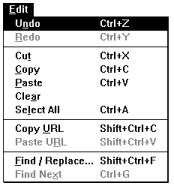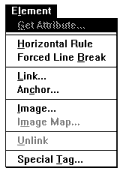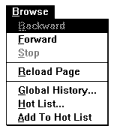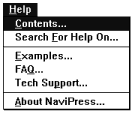 Help
Help
The File pull-down menu. You use it to
operate on Pages either locally or remotely over the network.


- New MiniWeb
- Creates a new MiniWeb.
- New Page
- Creates a new, empty page window.
- Open...
- Starts the Open dialogue that lets you
browse (either locally or remotely on a NaviServer)
for files or allows you to specify the URL directly. You
may also choose how you want the file manipulated
(e.g., you can open an HTML page as a Text
page and see the tags).
- Close
- Closes the Page window. Prompts if you have unsaved
changes.
- Save
- Saves the current Page.
- Save As...
- Invokes the Save As dialogue, to save the
Page either locally or on the network. Lets
you choose formats and various options.
- Import...
- Invokes the Import dialogue, to import a
file as text or HTML into the current page.
- Delete...
- Invokes the Delete dialogue, to let you
browse through the directory system and delete URLs.
- Print
- Invokes the Print Setup dialogue, to let
- Setup...
- you specify printers and their characteristics.
- Print
- Invokes the Print dialogue, to let you send the Page
to a printer.
- Exit
- Exits GNNpress. Prompts if you have unsaved changes.
The Edit pull-down menu. You use it to
modify your Page.

- Undo
- Undoes the last editing operation (some operations,
like Insert File may not be undone). There is no limit to
the number of Undo's, so in theory you can to keep
Undoing until you return to your original
page.
- Redo
- Reverses the last Undo.
- Cut
- Saves the selection to the clipboard and then deletes
it.
- Copy
- Saves the selection to the clipboard.
- Paste
- Transfers the contents of the clipboard to the current
Page, either at the current insertion point or deleting
the selection. If the clipboard contains an
URL from a Copy URL command, then if there
is a selection the selection becomes a link to that
URL, if not then a link to that URL is inserted with the
title of the page as the anchor.
- Clear
- Deletes the selection without saving it.
- Select All
- Selects the entire page.
- Copy URL of Page
- Saves the URL of the current page (or if the selection contains
a link then the URL in the link) into the clipboard in
such a way that pasting it yields a link.
- Paste URL
- Equivalent to Paste, except the URL is pasted
and the selection (if there is one) becomes the anchor
to a hyperlink. If there is no selection, then the title
of the URL becomes the new anchor.
- Find/Replace
- Invokes the Find/Replace dialogue. This has lots
of options to find and replace text.
- Find Next
- Repeats the last Find without presenting a dialogue.
The Element pull-down menu. You use it
to add special features to your Page.

- Get Attribute
- Invokes the appropriate dialogue for manipulating
the selection (i.e., Link dialogue for a link,
Image dialogue for an image, etc.)
- Horizontal Rule
- Adds a horizontal line at the insertion point.
- Forced Line Break
- Forces a line break at the insertion point.
- Link...
- Invokes a dialogue that lets you attach
links to a selection. If the selection
contains an existing link, shows whatever the link points
to and allows you to alter or remove it.
- Anchor...
- Invokes a dialogue that allows you to attach a name
to a point in the page. This name may be used in links
to move to that point in a page.
- Image...
- Insert an inline image into the page.
Invokes a dialogue allowing you to pick a
picture to insert and provide alignment
information.
- Image Map...
- If the selection contains an image,
invokes a dialogue that allows you to
make a clickable image and helps you
develop a map file for it.
- Unlink
- Removes the current link.
- Special Tag...
- Allows you to insert an HTML tag, even a tag that
GNNpress does not understand. Select text, bring up this dialogue,
and type in a tag. GNNpress brackets region by a begin tag and an end
tag. With no selection the tag you entered is inserted without an end
tag. If GNNpress recognizes the tag you insert, it checks that
you are using it appropriately. You may also change attributes on the
paragraph you are in by typing in the paragraph's tag followed
by new attributes.
The Format pull-down menu. You use it to
add structure and appearance to your Page.
Format menu selection in the Page menu (short menu
on
right)


- Exit List Format
- Creates a new paragraph outside the current format item (e.g.,
list, form, heading, preformatted paragraph, etc.) and puts the cursor
there.
- Remove List Format
- Removes the current formatting. If the cursor is in a list, heading,
... it undoes the formatting of the entire list, heading, etc.
- Type Style
- Invokes another pull-down menu that shows the various emphases defined
by HTML and allows you to pick one to apply to the selection.
- Heading
- Invokes another pull-down menu that lets you to turn the selection
into one of six levels of headings.
- Paragraph
- Invokes another pull-down menu that lets you create one of several
types of paragraphs.
- List
- Invokes another pull-down menu that lets you create one of three types
of lists-Numbered, Unnumbered, Definition. It also lets you
reverse terms and definitions in a Definition list.
- Form...
- Insert a form. This requires that you
give the URL of a Tcl, C, or CGI script on your server that runs
when the form is submitted.
- Show Borders
- Draws a border around forms and lists so you can see where they end.
If the border exists, command changes to Hide Borders.
- Style Sheet...
- Invokes a dialogue allowing you to change the
mapping between HTML elements and the screen format.
The Tools pull-down menu. You use it to
show information in your Page and customize GNNpress.


- Show HTML...
- Brings up a small window showing the HTML text
for the current page.
- Check Links...
- Invokes a dialogue that runs through all
the links in the current page and checks to make sure the URLs they reference
exist.
- NaviLink Page...
- Invokes a dialogue that asks you for a server.
It then searches the server to find other pages that are related to the
current page and suggests links to them.
- Search Server...
- Invokes a dialogue that lets you query a server. It brings up an HTML
page with a list of all the search methods available on the server. Clicking
on a link brings up a search form.
- Administer Server
- Invokes a dialogue that lets you administer
a server. After you select the server, GNNpress launches an HTML page with
links to the
administration functions for the server.
- Administer Page
- Invokes a submenu consisting of:
- Pricing...
- Brings up an HTML page with a form that allows you to control the "cost"
of retreiving the current page from the current server (you will probably
be prompted for a username and password before being allowed to do this).
- Permissions...
- Brings up an HTML page with a form that allows you to control who can
access the current page on the current server (you will probably be prompted
for a username and password before being allowed to do this).
- Archive Versions...
- Brings up an HTML page showing a list of all the archived versions of
the current page on the server and allows you to select one to look at.
- Describe Page...
- Brings up a dialogue asking for a server. It then brings up an HTML page
with a form which allows you to add meta-data descriptions for the current
page (note the current page need not be on the server).
- Preferences
- Invokes a submenu consisting of:
- General
- Allows you to set various things that refer generally
to GNNpress.
- Extensions/MIME...
- This associates a MIME type to a filename extension. These only refer
to files read locally from the disk or to files retrieved by some access
method other than http.
- MIME / Viewers...
- If GNNpress does not know how to display a file then it will
look through this list which associates MIME types to programs, and if it
finds something will run that program on the given file.
- Save Filters...
- This allows you to specify a program to be run to perform a translation
from html into some other format. All these translation types will be displayed
allong with the default ones (HTML, TEXT) in the Save
As dialogue box.
- MiniWeb Icons...
- This allows you to associate an icon with a MIME type. The icon will
be displayed in the graphical miniweb view to indicate a file with the given
MIME type.
- Naviservers...
- The search, NaviLink and publish commands all need a server to publish
to. This provides one way to enter that information. It is probably more
convenient to get it by loading the appropriate link, but that is not always
possible.
The Browse pull-down menu. You use it to
efficiently find and display new or old Pages.

- Backward
- As you follow hyperlinks in the Web, a history of Pages is built
up. Lets you traverse backward through the history.
- Forward
- Walks forward through the window history.
- Stop
- Aborts any outstanding read requests controlled by this window.
- Reload Page
- Reloads the current page (and all images in it) from the server.
- Global History...
- Invokes a dialogue showing all pages you have looked at in this session.
You choose to view one by double-clicking on it.
- Hot List...
- Invokes a dialogue of pages you have thought
important enough to stash their URLs in a list. You choose to view one
by double-clicking on it or pressing Fetch.
- Add to Hot List
- Adds the current Page's URL to the Hot List.
This menu appears in MS Windows only. With these commands
you can arrange the Page and MiniWeb windows in your workspace.

- Tile
- Arranges your Page or MiniWeb windows so that they are visible side-by-side
or bottom-to-top.
- Cascade
- Arranges your Page or MiniWeb windows so that they overlap and their
Titles are visible.
- Arrange Icons
- Arranges icons of minimized Page or MiniWeb windows.
Help menu selection in the Page
menu

- Contents...
- Shows a hyperlinked table of contents to the GNNpress documentation.
- Search for Help...
- Invokes a dialogue that lets you search the documentation on key words.
- Examples...
- Shows examples of uses of GNNpress.
- FAQ...
- Frequently Asked Questions (FAQ)
- Tech Support...
- Shows e-mail addresses and telephone numbers for technical support.
Clicking the mail link activates a dialogue to send
us a mail message.
- About GNNpress...
- Shows marketing information aboutGNNpress, plus the version number of
your copy.